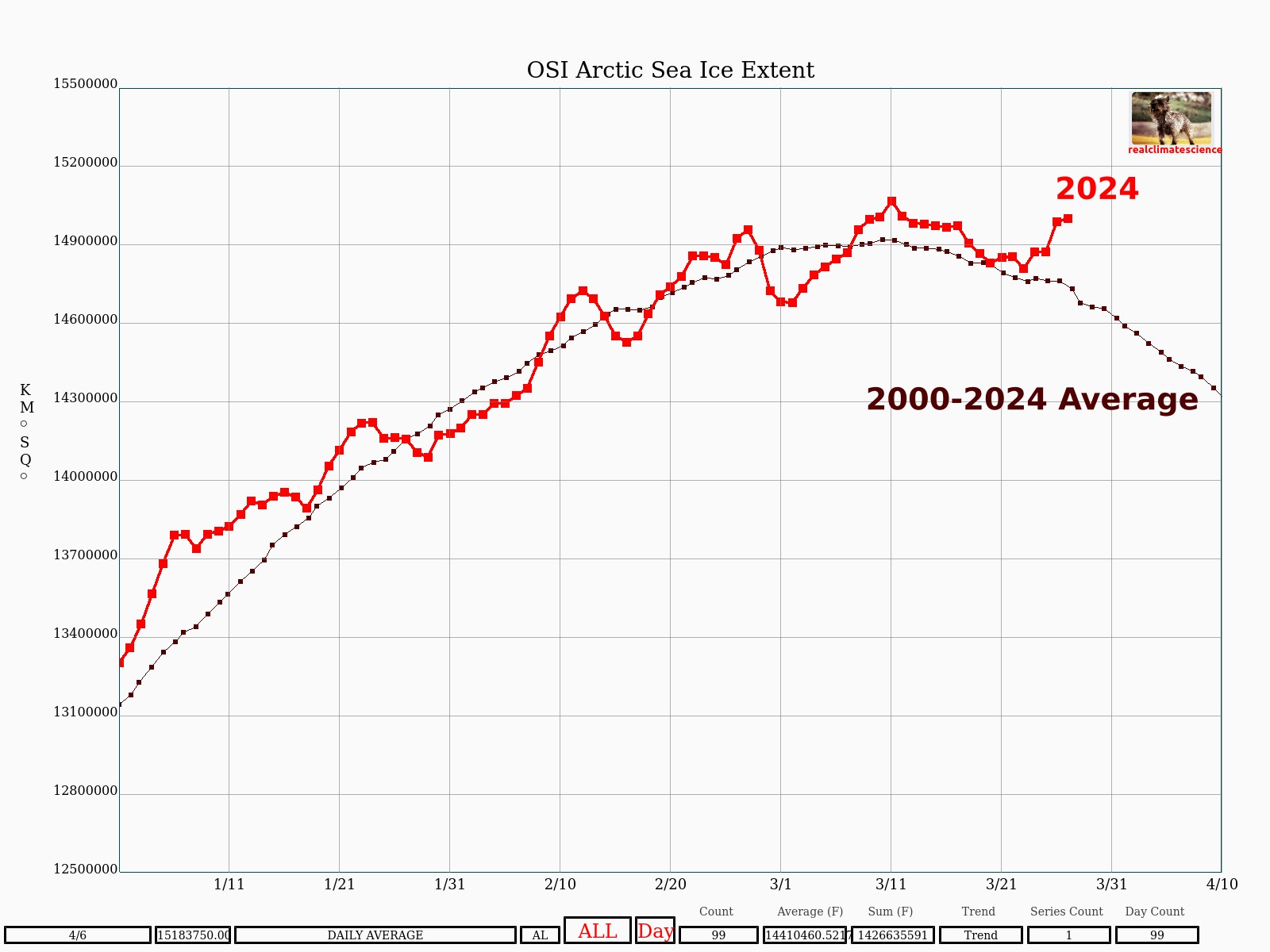“The Arctic could see summer days with practically no sea ice as early as the next couple of years, according to a new study out of the University of Colorado Boulder.”
Arctic could become ‘ice-free’ within a decade | ScienceDaily
Projections of an ice-free Arctic Ocean | Nature Reviews Earth & Environment
There has been no trend in the Arctic sea ice maximum, minimum or mean extent over the last seventeen years, and extent is well above the 21st century average.
ftp://osisaf.met.no/prod_test/ice/index/v2p2/nh/osisaf_nh_sie_daily.txt






Deluded double-thinking academics. AMO and Arctic warming is normal during each centennial solar minimum, due to increased negative North Atlantic Oscillation conditions. Rising CO2 forcing is universally modeled to increase positive NAO conditions, which can only drive a colder AMO and Arctic.
https://archive.ipcc.ch/publications_and_data/ar4/wg1/en/ch10s10-3-5-6.html
Okay I was just reading that, in order to explain past Ice Ages, they have created a black box, X, that changes atmospheric CO2 based on orbital patterns, and then the CO2 controls the temperature. It couldn’t just be that the orbital pattern directly impacts the temperature.
Conrad, as I understand it, cyclic growth and shrinkage of glaciers have occurred for the past 3 million years. These cycles are called glaciations, not ice ages as many newspapers would have you believe. We are currently in an ice age, by definition a period of time when permanent ice exists at the Earth’s poles. From 1 million years ago to today, there have been 10 or 12 glaciations (depending on which ups and downs are counted) when, at the lower temperatures of these cycles, ice covered much more of the earth than it does now. We are presently in the most recent relatively warm interglaciation period and have been for several thousand years providing the climate you now live in. These cycles occurred about once every 100,000 years and apparently correlate with “Milankovitch cycles” which are repeating patterns of variation of the Earth’s distance from the sun and the degree of tilt of the Earth’s rotational axis. Based on measurements of CO2 in ice cores, the cycles inversely correlate with temperature, i.e. as temperature declines, CO2 decline follows (probably because cold seawater can hold more) but never leads. Going back further between 3 million and 1 million years ago, the cycles occurred about 41,000 years apart. As I understand it, the 41,000 year cycles do not correlate with Milankovitch cycles. Further back in time, geologic evidence suggests that there were at least two very severe glaciation periods when the Earth was covered or nearly covered entirely with ice.
It’s a great puzzlement. Perhaps some day we will understand the causes of these cycles. One thing is clearly known, CO2 levels have nothing to do with them.
This has nothing to do with my original comment, but the 41kyr period is the obliquity component of the Milankovitch cycles.
The modal frequency of interglacial periods of the last million years is about 84,600 years, just over two obliquity cycles. Though there are a couple of shorter intervals of about 31,000 years. Periods of 9 obliquity cycles (369kyr), interglacials are well timed with obliquity cycles, so there is something else at play causing the variance with the obliquity cycles.
Milankovitch would have considered a solar variability component, he had proposed that heat and cold waves are discretely solar driven, but the academic gossip was that he was insane.
Note the mirror image symmetry around 11c, the red lines are all 369kyr:
https://snipboard.io/a1oj9P.jpg
I think it would be an amazing coincidence for a climate mode to correspond exactly to any particular Milankovich cycle. Treating the system as a linear oscillator, the gain is still greater than unity at double the resonant frequency, so it is quite possible for an 80-odd year cycle to be excited by a 40 year cycle input. I imagine actual resonance would have seriously catastrophic effects.
untold things “could” occur
“I am time, the destroyer of all; I have come to consume the world.”
20 years later…. the same arctic ice free alarms from the warm-ongers
off-topic, but Tony has touched on this before.
https://atommedia.online/en/2024/01/17/v-severske-nachalsya-montazh-reaktornoj/#:~:text=Rosatom%20has%20achieved%20a%20landmark,165%20tons%20has%20been%20installed.
10 years dammit!
And this time we mean it!
Send more money.
How much did this research cost? Whatever it is, it was a complete rip-off, like the other 200 billion squandered on this idiocy.
speaking of ice, I live in Central Minnesota and the state of Minnesota keeps track of when the mn lakes lose their winter ice cover. not all the lakes are tracked and some of the records only go back 25 to 75 years. currently the lakes in the southern half of the state have all lost their ice cover and that is recorded at this link. https://www.dnr.state.mn.us/ice_out/index.html. what isn’t recorded is that some of these lakes have regained their ice cover due to the past 2 weeks being very cold and snowy. a month ago there was no snow in my yard and now there’s almost a foot. it seems that the early ice outs and lack of snow a month ago were just a tease by mother nature
They may have a point. According to the DMI algorythm of Artic Sea Ice extent, the ice cap dropped 6.8 million square kilometers in March, 2024 in just a 2 days. Although it did recover just as fast. 😉 https://ocean.dmi.dk/arctic/icecover.uk.php
Acacemia is a misnomer. It should be propagandemia.
The purpose of academia is to produce ‘science’ which supports government policy, so that the government can claim to be ‘following the science’ when in fact, it is leading it through appropriate investment in persons of limited integrity and honesty.